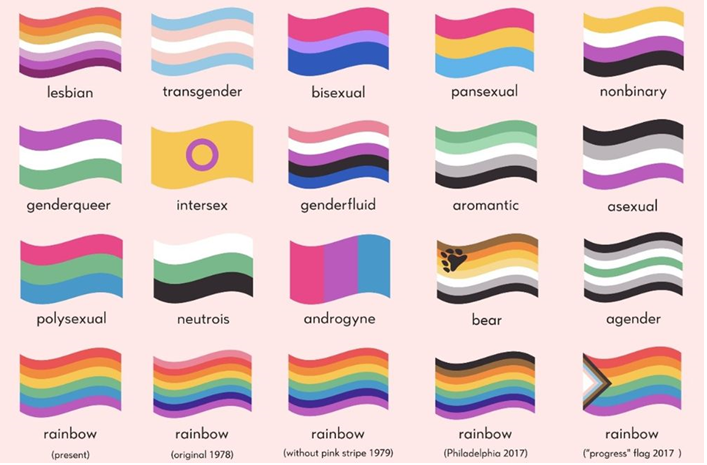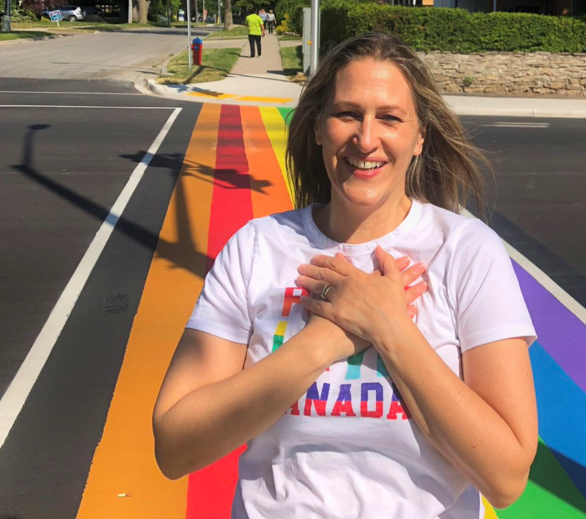 By Pepper Parr
By Pepper Parr
March 13th, 2024
BURLINGTON, ON
There are places in the city where the LGBTQIA2-S Pride Flag is not welcome.
It has been a long journey; sometimes you have to look back to appreciate just how far you have come.

The flag serves different parts of the community in different ways.
Flags are sociopolitical symbols of community membership, unity, and visibility. Over the years, the Pride flag has evolved to promote greater inclusion and recognize the many communities that celebrate Pride.
The flag has been updated and expanded to represent the intersectional diversity of lesbian, gay, bisexual, transgender, queer, intersex, asexual, and Two-Spirit (LGBTQIA2-S) communities.
Before rainbow-striped Pride flag, many LGBTQIA2-S communities used a pink triangle as visual representation. This was adapted from badge that gay prisoners were forced to wear in Nazi concentration camps.
In the late 1970s, Harvey Milk –the first openly gay man elected to public office – asked his friend Gilbert Baker to design a symbol to represent (what was then referred to as) the gay community. Baker collaborated with his friend Lynn Segerblom (also known as Faerie Argyle Rainbow) to design the rainbow-striped flag with eight colors.
The flag was first seen at the Gay Freedom Day Parade in SF in 1978. Each of the original eight colors had their own unique symbolism. Hot pink: sex; Red: life; Orange: healing; Yellow: sunlight; Green: nature; Turquoise: magic and art; Indigo: serenity; and Violet: spirit. The original flag’s hot pink and turquoise stripes were soon removed because of difficulty manufacturing and/or dying the fabric, resulting in the six-color rainbow flag we are familiar with today.

Mayor Meed Ward has always let people know where she stands on the flag issue.
Many groups within the LGBTQIA2-S community have their own Pride flags. There are specific flags celebrating the identities of transgender, bisexual, lesbian, pansexual, asexual, and other communities. Still, the rainbow-striped flag has historically been the most used and recognized symbol representing Pride for the LGBTQIA2-S community overall.
There were other revisions – Burlington chose the six colour version and placed them at several crosswalks in the city.
Progress.















The Canadian flag includes and represents every Canadian, that is the only flag that needs to be flown at government offices and agencies.
Excellent article – however the most recent iteration of the Pride Flag is not shown.
The Progress Pride Flag (2023 version) includes a purple circle in the yellow triangle to respect inclusivity of those not represented on the previous designs.
Whichever style – and don’t forget the rainbow park benches in the city – all makes for a more welcoming place to be.
https://www.verywellmind.com/what-the-colors-of-the-new-pride-flag-mean-5189173
I fully realize that my remarks – to follow – will probably lead to considerable backlash to my poor, unconfused self. But, perhaps it’s time that we tried to put things into perspective. First, whatever sexual orientation one wants to adopt, I could truly care less. Honestly, I really, really don’t care. Live your lives as you want and should – God bless.
But look at the flags – 20 of them. Are these the banners of a unified and ‘inclusive’ section of our population or simply isolated splinter voices, all trying to be heard and observed, one above the other and largely to the detriment of each other? How important is this freedom of gender/sexual expression in the face of fundamental existential challenges such as available housing, effective healthcare, educational reform, environmental sustainablitlgy etc. Isn’t it time that we crossed our palms and focused our attention on the issues that involve the greatest number of our citizens and pose the greatest threat to our continued well being?
Well said, couldn’t agree more!
Isn’t part of being treated equally actually being treated equally? I’ve never understood why minority groups need special treatment when all they claim they really want is equal treatment. Perhaps they need to understand that being treated equally means not really paying much attention to you in the first place. Most of us really don’t care, no need to rub anything in our faces. Live your life to the fullest without demanding special attention. That’s what being treated equally actually looks like.
One confused person to another; A walk West along the beach to the pier will bring you to burlington’s latest homeless encampment, homelessness and poverty under the right circumstances treat’s everyone equally.
Well stated Sue!
We have far more important issues in this community that need to be addressed. I, and I daresay, the majority of residents, couldn’t give two figs about someone’s sexual orientation. Gay, straight bi-sexual….who cares?
As Michael has noted, the only flag that should be flying at City Hall is the Canadian flag. Ditto schools and other public institutions. If someone wants to make a statement and fly the 2SLGBTQ flag on their property feel free to do so, but don’t expect the rest of us to blithely “tow the line”.
The crosswalk at Drury looks terrible and has for years despite it being redone shortly after it was first painted due to the same issue. If the cause is so important to them, why haven’t they fixed it? Or is it more for the photo ops like the one above and they’ve got those so …
“Mayor Meed Ward has always let people know where she stands on the flag issue”. which is a good thing to do. However, she doesn’t own up to the city fully understnding the cost of the rainbow crosswalk she is stood on was paid for out of funds provided to the city to meet RURAL DOWNTOWN business needs, which is not a good thing. The Toronto Pride organization was made to pay back federal funds that were not used for the purpose provided to the organization.